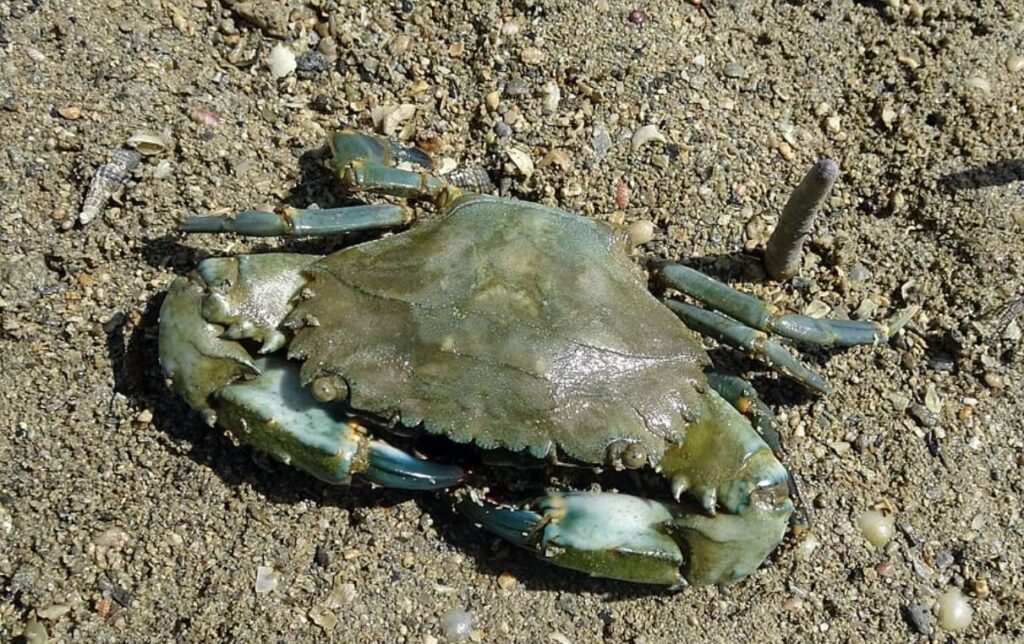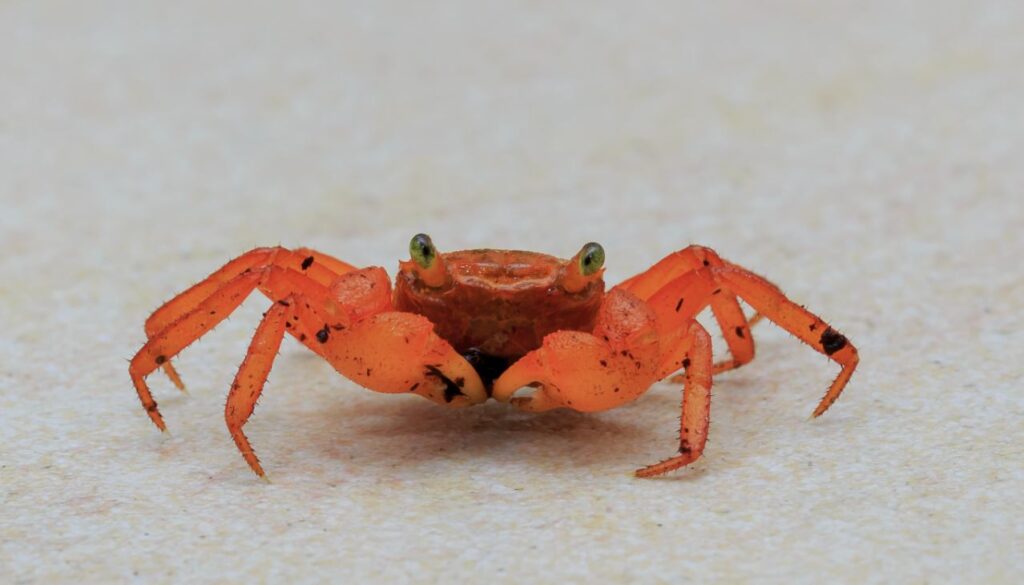Crabs and scorpions have similar attributes that could confuse people in determining one from another. However, these two creatures differ in many ways, including their anatomy, taxonomy, behavior, and habitat. Each difference will be individually discussed in this article.
How To Distinguish a Crab From a Scorpion
Body Frame and Appearance
Crabs: These round-bodied creatures are covered with a large, thick shell and circular exoskeleton. They have four pairs of legs and a pair of claws or pincers, which are readily noticeable. Most crabs have two pairs of antennae. It is a feature that distinguishes them from other related arthropods and within crab species.
Scorpions: Scorpions’ bodies are rather elongated compared to crabs. They also have four pairs of legs and one pair of pincers. But their pincers are smaller than that of the crabs. The primary thing that distinguishes a scorpion from a crab is its extended, segmented tail that curls forward and is tipped with a venomous stinger.
Common Colors
Crabs usually come in brown, olive-green, or gray colors when alive, but they turn into bright red when they are cooked.

Scorpions can be found in a wide range of colors. Most of them are yellow or black that provides camouflage to help them blend in with their surroundings. Some appear in colors red or brown, depending on the species. At night, you can readily spot a scorpion if you switch on an ultraviolet light. The scorpion glows and appears in a bright blue-green color under the UV beam.

Location and Design of Their Eyes
The two stalks that seem to have grown from a crab’s head are actually where the crab’s eyes can be found. These eyestalks have thousands of light-sensitive facets that allow them to see things 360 degrees around them. This keen vision of crabs helps them in detecting danger instantly so they could run for cover.
On the contrary, scorpions can’t see very well. It’s quite ironic, considering that they have two eyes on top of their head and two to five eyes along each side, depending on the species. Though they can’t see very well, the sensitivity of their eyes is remarkably high. It is among the highest in all arthropods. The sensitivity is said to be dependent on its habitat. Their high-sensitive eyes allow them to still recognize movements around them even with poor eyesight.
Their Pincers
Crab pincers are larger than scorpion pincers. The size usually depends on the body frame and species of the crab. Scorpions have smaller pincers. But they’re also used to grab and hold things or food.
Habitat: Water or Land?
Many species of crabs can live in both saltwater and freshwater. Some species prefer to live in shallow sea areas, while others survive in deep ocean beds. Some could even survive on land. That’s why some crabs can be found scuttering sideways near a beach, a muddy lake, or a sea cliff. Different species have evolved to survive different changes in habitat. Scorpions, on the other hand, mostly live in deserts, rainforests, and semi-arid regions. They can be commonly found lurking under rocks and logs.
What Crabs and Scorpions Feed On
Crabs are omnivorous animals. They feed primarily on algae, but they can also take in other food, such as worms, mollusks, and smaller fishes or other crustaceans. Scorpions, on the other hand, typically feed on insects. But to survive in harsh areas and conditions, scorpions can also eat almost any prey that they can capture, given that it is smaller than them.
How They Hunt and Eat Their Prey
Crabs use their pincers or claws to grab and hold food pieces, and then they put them into their mouths. They also use their pincers to break the food into smaller pieces, making it easier for them to ingest. Their strong pincers come in handy, especially when they have to hammer down shells of other sea creatures that they’re going to eat.
Scorpions also use their pincers to capture their prey. While in the hustle, they use their poisonous stingers to inject neurotoxic venom to their victim. Eating the prey becomes easier for them as it is already paralyzed because of the venom. Scorpions can only ingest liquids, so they ought to discard solid matters that they’ve eaten. They use their chelicerae, which are small and sharp structures in their mouth, to pull a small amount of food from the prey and discard the solid matter.
Movement and Speed
Most crabs move or walk sideways. Though they can still move forward, backward, or diagonally, it is easier and faster if they move sideways. This is because their legs are stiff and are bent outward. This particular design makes the sideward movement to be more efficient for them. Walking sideways is one characteristic that could readily determine a crab from a scorpion that rather moves in a forward manner. Scorpions are usually faster in movement than crabs.
Questions and answers About Crabs and Scorpions
Question: Are Crabs and Scorpions Both Crustaceans?
Answer: Crabs and scorpions both fall into the family phylum Arthropoda or Arthropods. However, the two belong in different subphylum. Crabs are categorized under crustaceans, which also include shrimp, lobster, and krill. On the other hand, scorpions are arachnids and are closely related to spiders, ticks, and mites.
Question: Are Crabs and Scorpions Both Edible?
Answer: Crab dishes are common inclusions in restaurant menus. Most crabs are safe to eat, but some species carry a lethal dose of toxins. A small percentage of the family Xanthidae is known to be toxic. These types of crabs are notable for their black-tipped pincers. But unlike scorpions, these poisonous crabs don’t produce the toxins by themselves. It’s likely obtained from their diet or environment. Scorpions, on the other hand, are edible, even though they have venomous stingers. In some countries, scorpions are one of the exotic foods found in restaurants or street food stands. Of course, the stinger and venom gland must be removed before consumption, especially when the scorpion is eaten without being cooked.
Question: Fight Between a Crab and a Scorpion: Who Would Win?
Answer: In a crab versus scorpion matchup, the crab has an advantage in terms of crushing power and defensive armor. However, the scorpion here has a deadly weapon, which is its venomous stinger. If the scorpion happens to find a weak spot on the crab’s armor shell and injects its venom into it, then it can be deadly to the crab. But otherwise, the crab is at an advantage.
Question: Can Scorpions Live in Water?
Answer: Scorpions usually live on land. But when submerged in water, a scorpion can live for up to two days. You may have also heard about water scorpions. These creatures are not true scorpions. However, they are called as such because of their superficial resemblance to the said arachnid. A water scorpion is an insect, not an arachnid. It is a brown, predacious water bug that uses its front, pincer-like legs to capture its prey.
Question: Is horseshoe crab a type of crab?
Answer: A horseshoe crab is not a crab. It is not categorized as a crustacean as it belongs to a different order. Horseshoe crabs are rather more related to spiders, scorpions, and other arachnids. They have smooth, hard shells that are shaped like horseshoes, thus their names.
Question: What is a pseudoscorpion?
Answer: Pseudoscorpions, though referred to as “false scorpions,” are arachnids closely related to the real scorpions, spiders, and mites. They are called as such because they resemble a true scorpion. They also have a pair of pincers, but their bodies are flat and oval. They also do not have the signature stinger of a scorpion.
Question: Is scorpion venom deadly to humans?
Answer: Scorpion stings can be really painful but are rarely life-threatening. However, it must not be taken lightly. The neurotoxins from the sting could cause nausea, vomiting, hypersalivation, and sweating. If symptoms appear to be more severe, immediately seek medical assistance. The severity of the symptoms depends on the number of neurotoxins released by the scorpion entering the human body. If the release is too massive, it could result in a more critical condition that could be fatal to the body.
Question: Does scorpion meat taste like crab?
Answer: Some say that a scorpion, when eaten, tastes like beef jerky with a slight fishy taste. It’s crunchy, and it tastes like seafood, almost similar to a soft-shelled crab. Crabs with hard shells have to be opened before getting the meat. But with scorpions, you just bite the whole piece and savor its crunchiness and nutty taste. Scorpions can be fried, grilled, or roasted before consumption. The venom is said to become non-poisonous when cooked. But some would dare eat a live scorpion. They just have to get rid of the stinger and venom gland before consumption.
Question: How can crabs breathe both on land and underwater?
Answer: Crabs, like fish, have gills that let them breathe underwater. But unlike any fish, crabs can adapt to breathing in the atmosphere. As long as the crab’s gills stay damp, oxygen from the atmosphere will diffuse into the water on the gills. Crabs can minimize the amount of water evaporating from their gills, thus preventing them from drying out easily and letting them breathe on land.

